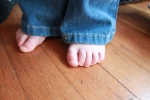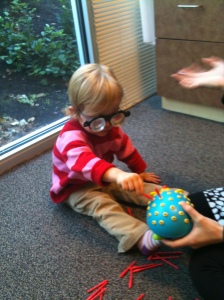The Great Peripheral Awakening of 2011
A few weeks ago, I noticed a distinct change in Stella’s vision. Bam! It could not have been more obvious if she slapped me across the face and said, “Damn it, mommy woman! My vision is changing! Give me a god damned hug!”
In short, her peripheral vision opened up in dramatic fashion. Last year, when the esotropia hit the amblyopia fan, I would not have even known that Stella’s peripheral vision was limited if not for the input of our developmental optometrist and vision therapist. Our ophthalmologist never made mention of peripheral vision, which is a sizable piece of the pie in terms of how we take in our surroundings. It affects how we feel, not just how we see. Anyway, I suddenly had clear evidence that Stella’s peripheral vision had been turned on or amped up by the yoked prism goggles, or at the very least she became more aware of it and more tuned in to her surroundings.
How did I know? Walks became more stressful for a while. We live in a bustling urban neighborhood. In fact, it’s been declared the dessert capital of Seattle, with quaint cupcake, gelato, ice cream, chocolate, and pie shops all within a couple blocks. Strolls can be highly caloric, though I like to think we break even, what with the ambulatory mode of transport. For a while during this period of visual transition, when we walked along the sidewalk and approached a crosswalk leading to some sort of sweet destination or none in particular, Stella would get very upset. She experienced panic at intersections. At first I didn’t quite get it or its significance, and in my ignorance probably thought, “Yeah, I wish the cupcake place was closer, too! Mommy needs chocolate NOW!” Honestly, her agitation was too high to downplay and her actual reasons became clear quickly. Her anxiety was sparked by cars approaching from the cross street. She reacted as if the cars (moving in our direction on the cross street, so at a perpendicular trajectory, and I should really have my engineer husband proofread this) were coming straight for us. She lacked the common, seemingly natural understanding that vehicles would stop for us if we just waited at the curb. She was downright afraid they would hit us–even if they were a good half a block away. Stella refused to walk all the way up to the curb to wait to cross, she wanted to stay back from the road, so that’s what we did for a while. Until the fear faded away and she found a new “normal.”
Stella simply wasn’t used to being able to see the cars’ motion in her periphery. The difference was clear as day and her reaction was made my heart race. I knew that a sizable shift was taking place. My gut had no doubt that this was a positive development, and that she was simply noticing the previously unnoticeable, but I also felt her visceral fear and desperately sought to soothe and reassure her. The intersections that never bothered Stella before, with the usual rhythm of cars coming and going, were now somehow very different to her. This was around the time that I noticed, during a vision therapy session with the yoked prism goggles, that she was locating letters on the floor without looking directly at them.
As she has time and time again throughout her 2.75 years, Stella adjusted. She learned that this is the way streets and intersections and crossings work. That cars approach but are not actually barreling for us. It wasn’t long before she incorporated this new broader, more inclusive view as normal. Stella now seems less afraid of most things, in fact. She’s been more and more social and talkative, and increasingly adaptable in general. Her babysitter recently marveled at the fact that most of Stella’s talking to her had been echoing, simply repeating what she’d said, but now Stella initiates and offers her own thoughts. The echoing is drastically reduced if not gone for the most part. We recently had company and Stella brought item after item to Cody’s best friend Tom, engaging him excitedly and chatting away. This is new behavior. Part of it may be simple advancements that come with age, but I think just as much is related to her vision. I have other observations to back this up, like her weeks-long fear of playground structures and other kids on said structures. That’s gone, too, and its disappearance coincided with what I’m calling, as you can no doubt guess having read my witty subject line, “The Great Peripheral Awakening of 2011.” If only the United States’ financial industry could follow suit.
Life is less stressful and more secure when you are aware of your surroundings, I imagine. To me, nothing feels better than seeing her happy. To witness her blooming into this more engaging, engaged, often fearless kid.
Like many people with esotropia, her vision has been focused centrally–like tunnel vision to some degree. We’ve done vision therapy for almost nine months now, and have devoted many recent weeks to use of the yoked prism goggles (20 minutes a day at home, with 10 of those base up and 10 base down) to open up her field of vision. Vision therapy, including our goggle time, will likely end in a few weeks. This Friday, Stella will have an exam with our opthalmologist, and a couple weeks later we’ll head in to Alderwood Vision Therapy see our developmental optometrist, Dr. T, for a progress evaluation. This is a crossroads. I’m still nervous about her amblyopia, and about whether her prescription will increase. But I’ve seen real progress that can’t be denied, including the minimizing of her toe-walking. I’ve been amazed on a weekly basis by the thoughtful, individualized approach and powerful yet nuanced, seemingly subtle but life-changing, results of vision therapy.
It’s been one hell of an eye-opening journey! (You didn’t think I’d given up terrible vision-related puns, did you?) When I look back, I’ve been most struck by my sharp yet sweet two-year-old Stella and her ability to adapt to a new way of seeing the world, a place that to her now feels wider and more welcoming.




